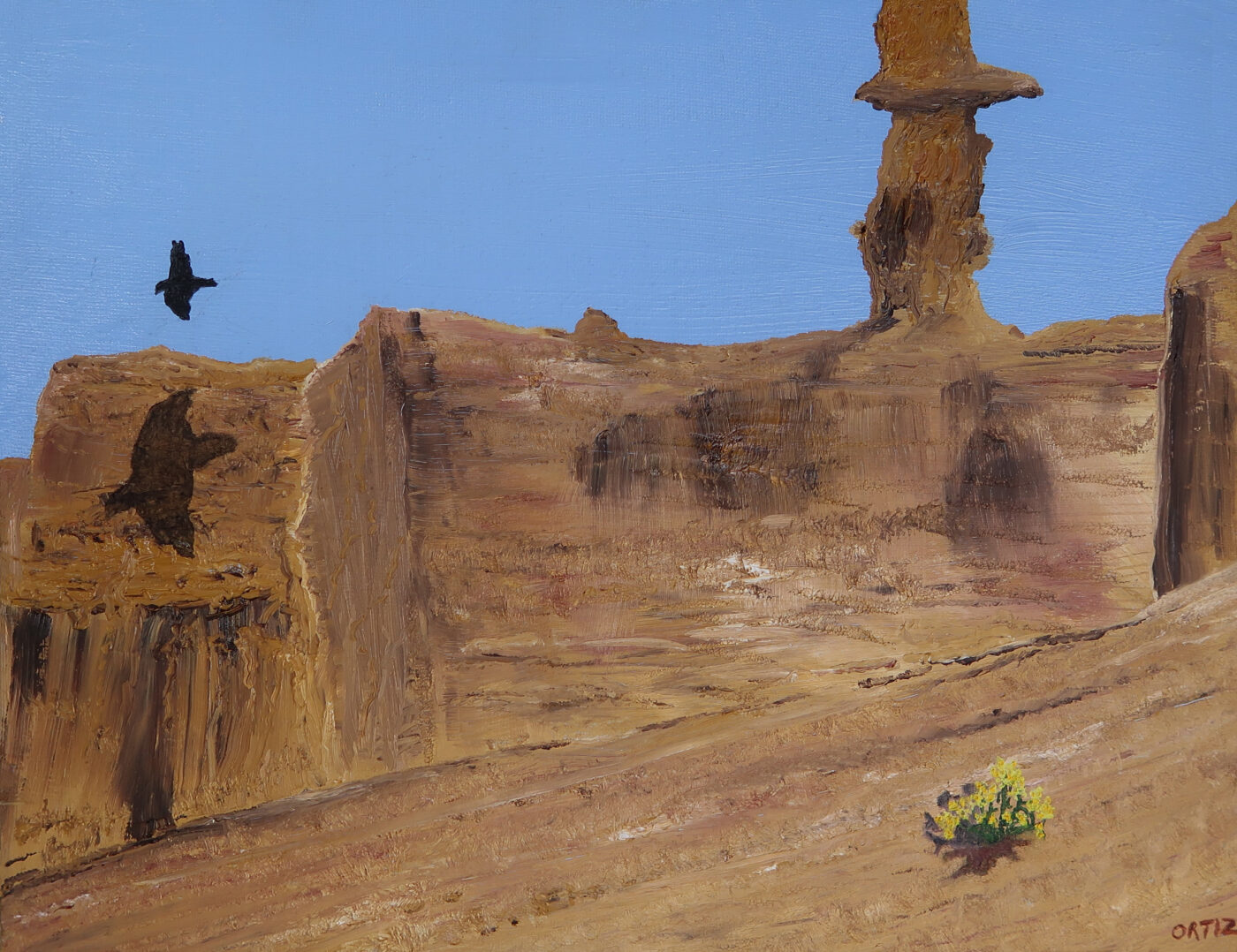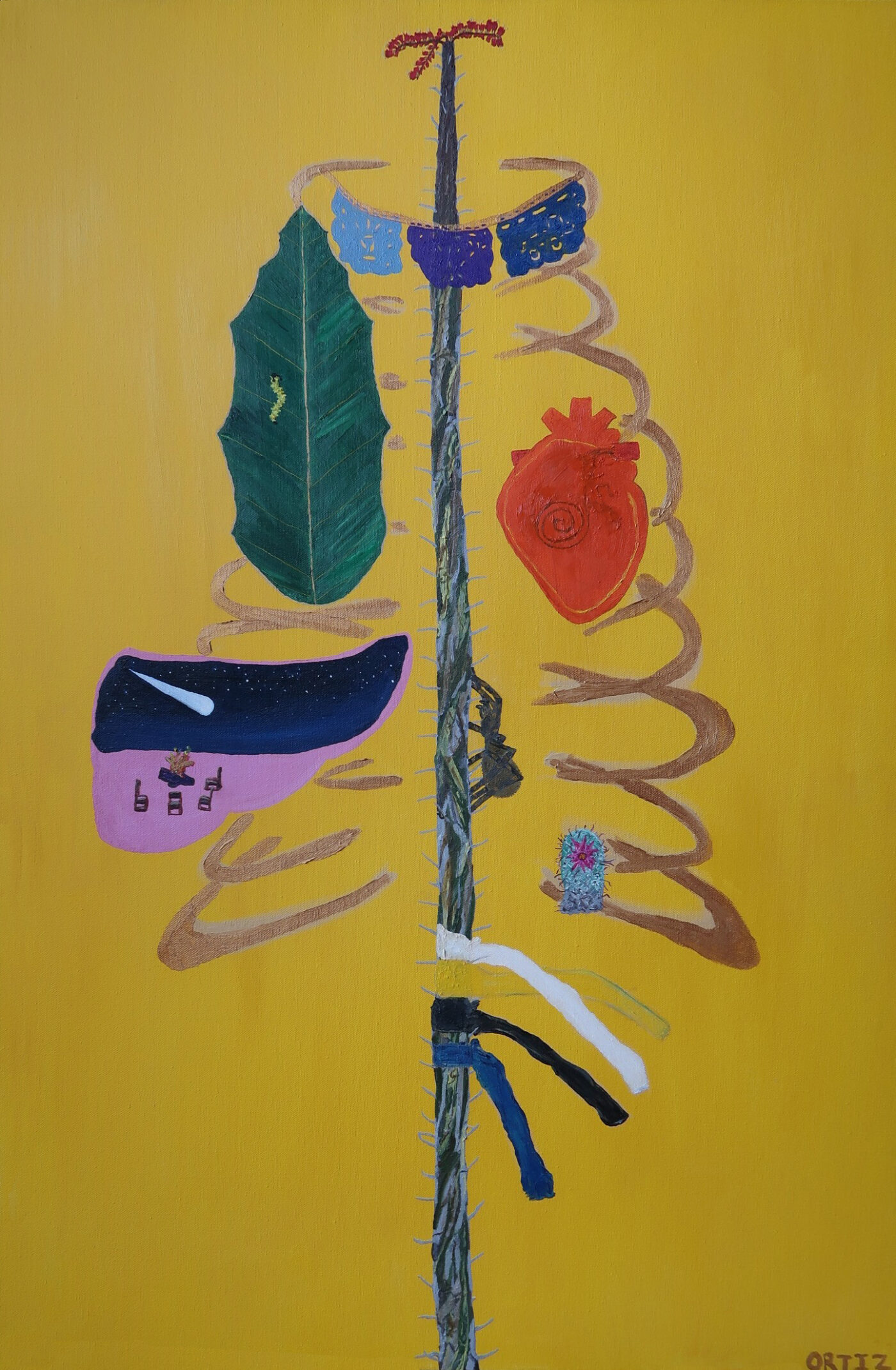“There is nothing new under the sun, but there are new suns.” –Octavia Butler
“There is nothing new under the sun, but there are new suns.” –Octavia Butler

5 minutes, or the time it takes to steep a cup of tea
Humans live moment by moment against the backdrop of deep time — of outer space and the geological history of our planet. Despite this, our existence here is far from temporary. Extractive technologies driven by capitalism have engendered enormous changes to our planet and its atmosphere. In “From Earth to Orbit: Excavating Time,” Naomi Ortiz offers an essay interweaving poetry, prose, and paintings, feeling through these different places where time is manifest. In doing so, they show how we can find joy and resilience with one another and our fellow creatures.
BY NAOMI ORTIZ
This desert was once an ocean
water lines mark mountain ridge
dry bajadas now silt stretch to floor
millions of years ago
or the period elders tell of earth-making spirits
depending on how you measure time
In the desert
packrat middens
carved under messy spreads of nopal pads
round and pancake flat
laced in thorns
conceals burrow dug deep
with collected pee-encased artifacts
that tell us the desert is not that old
What made a person
think to carbon date objects and plant matter
coated in dried, gelatinous animal bodily fluid?

[ID: Sandstone cliff walls and formation. A raven flies and their larger shadow glides over the cliff. A small flowering plant grows in a patch of dirt on the side of a cliff.]
My family drives over cracked asphalt through small mountains and rocky cliffs. Old mines pocket the hillsides like gaping mouths, all talk, not much follow-through. Except now, with satellites and deep earth core samples they come to claim more. In the hunt for copper, multinational conglomerates pick up from where prospectors left off. No longer a human endeavor with picks and shovels but machine labor drills 8,000 feet deep. Makes craters that collapse the land a mile and a half in on itself. Imploding a landscape into a waste pit.
The metal I criticize plink plinks in the engine of my truck as it cools from the long drive here. We camp amongst the creosote and ocotillos uphill from an intermittent river and on the other side of a narrow mountain from a mine. Even from miles away, the lights that tower from cranes wash out the stars, but we pick out those that blaze through and can still be seen. In the desert darkness, amongst coyote song, we try to remember their stories. The ones made popular by Greek mythology and the ones passed to us as secrets or in dreams. We cook a simple dinner over a small fire. The shadows of cacti stretch long. This might be an unexceptional place, not like the centers of culture and creation like Oak Flat, but the sounds like tiny bells or shells murmur through the river basin, water-blessings permeate the air surrounding thousands of feet.

[ID: A thorny ocotillo stalk topped with blooms comes up the center of the painting like a spine. Four prayer cloths are tied around the stalk. A spider crawls up the stem. The messy outline of ribs floats on a yellow background surrounding an anatomical heart, a leaf lung with a caterpillar crawling across, a liver shape with a nighttime scene of chairs arranged around a fire with a shooting star above, and a kidney pincushion cactus with a big bloom.]
I like to measure time in water
spongy ancient aquifer patiently collects until
through pressure
surges up impenetrable rock
copper soft
squeezes and widens cracks
to appear—a gift on the surface
like at Chi’chil Biłdagoteel /Oak Flat
Outside Superior
dug through geologic clock
2,000 feet deeper than the Grand Canyon
my lungs recognize the threat of extraction
a cavernous emptiness
of displaced rock
to cave in an area big enough
to nearly fit the town
The copper I criticize plink plinks in the engine of my truck as it cools from the long drive here. Night settles deeper, we run out of wood for the fire and the wind swings through the canyon. My eyes trace the dozen trails of star-like satellites. Our conversation quiets until suddenly a streak burns luminous through the atmosphere, a thick object blazing brilliant, growing wider, brighter, trailing across the night sky. We exclaim our delight, rally our energy to find laughter in what is shared.
We debate, meteor or space junk? I share that as CO2 heats up the air closer to Earth’s surface, it also cools the upper atmosphere. This cooling reduces the drag that pulls space junk down to earth, burning it up on the way. Scientists worry about all of the bits like discarded rocket stages and paint flecks that float perpetually around our orb of life. Debris can collide with the energy of a bullet or the power of a crashing bus. We wonder what satellite could it take out? When the trash falls, will there be enough friction and heat to save us from its impact? [1]
Human here
unable to move forward or back
collective mess
stuck in sacred middle
I coat and protect
this everyday place in future-fierce prayer
[1] Seth Borenstein, “Study says climate change will make Earth’s orbit a mess,” Arizona Daily Star, March 12, 2025.

[ID: Naomi Ortiz, a light-skinned Mestize person using a mobility scooter is behind ocotillo stalks, wearing silver hoop earrings, a bandana, a V-neck shirt, and dark lipstick.]
Naomi Ortiz
They // Them // Theirs
Tucson, AZ
Naomi Ortiz is a Reclaiming the US/Mexico Border Narrative Awardee (NALAC) and a 2022 Disability Futures Fellow. Ortiz’s collection, Rituals for Climate Change: A Crip Struggle for Ecojustice, offers potent insights about the complexity of interdependence, calling readers to deepen their understanding of what it means to witness and love an endangered world. Their non-fiction book, Sustaining Spirit: Self-Care for Social Justice, provides informative tools and insightful strategies for diverse communities on addressing burnout. Ortiz is also a co-editor of the forthcoming anthology, Every Place on the Map is Disabled: Poems and Essays.
Artwork by Ortiz is part of the permanent collection at the University of Arizona Disability Cultural Center; has been featured in group art shows in Tucson, AZ, Boston, MA, San Francisco, CA; and appears on book covers, postcards, and calendars. Their current projects include collaborating on the “Touch Back In-digi-nality” art project and “Heritage Sites and Ceremony from Bed to Land” along with moira williams, supported by the UK-based Landscape Research Group. As an Arizona US/Mexico borderlands-based Disabled Mestize poet, writer, facilitator, and visual artist, Ortiz explores how we create meaning and connection within states of rapid change.
naomiortiz.com
Instagram: @naomiortizwriterartist
